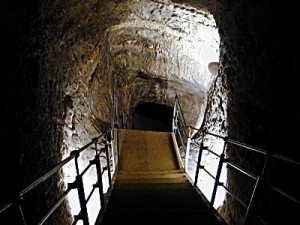Warren’s Shaft, 8th century BCE
In 1867 Captain Warren, in company with a crowd of pilgrims, visited the famous spring, which, according to the legend, is the place where Mary washed the swaddling clothes of her little son. Despite the semi-darkness Warren noticed on this visit a dark cavity in the roof, a few yards above the spot where the water flowed out of the rock. Apparently no one had ever noticed this before because when Warren asked about it nobody could tell him anything.
Filled with curiosity he went back to the Virgin Fountain next day equipped with a ladder and a long rope. He had no idea that an adventurous land somewhat perilous journey lay ahead of him.
Behind the spring a narrow shaft led off at first horizontally and then straight up into the rock. Warren was an alpine expert and well acquainted with this type of chimney climbing. Carefully, hand over hand, he made his way upwards. After about 40 feet the shaft suddenly came to an end. Feeling his way in the darkness Warren eventually found a narrow passage. Crawling on all fours he followed it. A number of steps had been cut in the rock. After some time he saw ahead of him a glimmering of light. He reached a vaulted chamber which contained nothing but old jars and glass bottles covered in the dust. He forced himself through a chink in the rock and found himself in broad daylight in the middle of the city, with the Fountain of the Virgin lying far below him.
Closer investigation by Parker, who in 1918 went from the United Kingdom under the auspices of the Palestine Exploration Fund, showed that this remarkable arrangement dated from the second millennium B.C. The inhabitants of old Jerusalem had been at pains to cut a corridor through the rock in order that in time of siege they could reach in safety the spring that meant life or death to them.
Excerpted from Werner Keller. The Bible as History. Bantam Books. New York. 1982.
See also:
- Jerusalem’s Water Supply During Siege, Yigal Shiloh, BAR 7-04, Jul-Aug 1981.
- BAR Interview- Yigal Shiloh—Last Thoughts, Hershel Shanks, BAR 14-02, Mar-Apr 1988.
- The City of David (map)
- I Climbed Warren’s Shaft (But Joab Never Did), Hershel Shanks, BAR 25-06, Nov-Dec 1999.
- Warren’s Shaft, Avraham Faust, BAR 29-05, Sep-Oct 2003.
- Charles Warren vs. James Fergusson, David Jacobson, BAR 29-05, Sep-Oct 2003.
- Jewish Virtual Library- Jerusalem – Water Systems of Biblical Times




